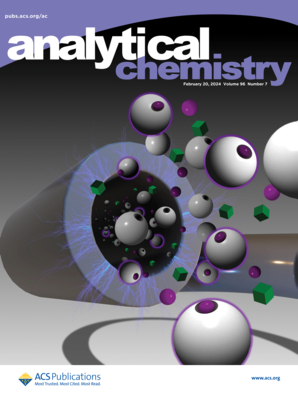用于细胞壁特异性成像和细胞膜损伤实时检测的膜渗透多功能探针的模块化设计
IF 6.7
1区 化学
Q1 CHEMISTRY, ANALYTICAL
引用次数: 0
摘要
本文章由计算机程序翻译,如有差异,请以英文原文为准。

Modular Design of Membrane-Impermeable Versatile Probe for Specific Imaging of Cell Walls and Real-Time Detection of Cell Membrane Damage
The versatile fluorescent dyes are essential for specifically labeling plant cell walls in vivo, monitoring plasma membrane damage, and assessing cell viability. However, such dyes are rare and often discovered accidentally due to a lack of design principles. Propidium iodide, a well-known example, has limitations like low brightness, high toxicity, and poor bacterial differentiation. To address these challenges, we developed VersaDye, a modular probe designed for specific imaging of live plant cell walls and monitoring plasma membrane damage in plant cells, human cells, and certain bacteria. The design integrates impermeability principles and environment-dependent fluorophore scaffolds. VersaDye enables bright, wash-free labeling of plant cell walls and can stain various plant organs for constructing 3D tissue organization. Notably, it can selectively distinguish live Gram-positive from Gram-negative bacteria, a feature absent in other dyes. Its impermeability and targeting ability also allow it to probe membrane damage caused by physical, chemical, and biological stimuli. This study marks the first use of VersaDye in analyzing cell damage in live plants under salt stress. VersaDye offers a robust platform for wash-free, in vivo membrane damage monitoring and simultaneous cell wall labeling. Additionally, its design suggests adaptability for regulating permeability to meet specific diagnostic needs, such as identifying membrane-compromised cells in diseases or enabling high-throughput antibiotic screening targeting specific bacteria.
求助全文
通过发布文献求助,成功后即可免费获取论文全文。
去求助
来源期刊

Analytical Chemistry
化学-分析化学
CiteScore
12.10
自引率
12.20%
发文量
1949
审稿时长
1.4 months
期刊介绍:
Analytical Chemistry, a peer-reviewed research journal, focuses on disseminating new and original knowledge across all branches of analytical chemistry. Fundamental articles may explore general principles of chemical measurement science and need not directly address existing or potential analytical methodology. They can be entirely theoretical or report experimental results. Contributions may cover various phases of analytical operations, including sampling, bioanalysis, electrochemistry, mass spectrometry, microscale and nanoscale systems, environmental analysis, separations, spectroscopy, chemical reactions and selectivity, instrumentation, imaging, surface analysis, and data processing. Papers discussing known analytical methods should present a significant, original application of the method, a notable improvement, or results on an important analyte.
 求助内容:
求助内容: 应助结果提醒方式:
应助结果提醒方式:


